Fairfield County Auditor
Timeline
This timeline marks significant points in its history: from when it was built by one of Lancaster's earliest merchants to when it housed the local Red Cross during World War II.
Throughout its history, the building has transformed to serve a new purpose many times over. There were also moments when its demolition seemed inevitable, but at every turn, the beloved brick building at 108 N. High Street was brought back to life.

-
1837
Thomas Ewing Sr., who served in the U.S. Senate and also as the Secretary of Treasury and the first Secretary of the Interior, bought and then sold the property five days later on Nov. 28, 1837, to Richard M. Ainsworth for $2,700. Ainsworth was one of the city’s earliest and most prominent merchants, selling all kinds of dry goods.
ENLARGE IMAGE
Ainsworth built the original home on the property, where his family, including his daughter Juliet Ainsworth Kinkead, resided. The Ainsworth home is believed to be the north section of the original structure, prior to the Fairfield County Auditor's most recent expansion.
Pictured: (left to right) Portrait of Thomas Ewing Sr.; Portrait of Juliet Ainsworth Kinkead.
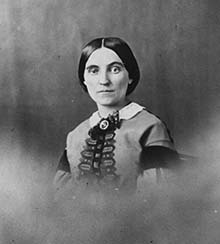
-
1847
Richard M. Ainsworth died at the age of 51 while en route to New York for a business trip May 14, 1847. After his death, his estate was declared insolvent.
ENLARGE IMAGE
Ainsworth's obituary appeared in the Daily Gazette on May 21, 1847: "The deceased was one of our oldest and most respectable merchants. He was universally beloved and esteemed by all who knew him ..."
The property, which had been appraised at $4,000, was subsequently bought and sold multiple times after the Ainsworth ownership.
Pictured: Latta & Ainsworth wholesale and retail dry goods advertisement in the Ohio Eagle from September 15, 1832.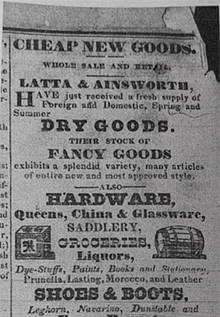
-
1859
John S. Snider, known as "The Great Wine King," purchased the home from Philemon B. Ewing Feb. 10, 1859, living there with his wife and six children.
ENLARGE IMAGE
Snider wore many hats; he was a carpenter by trade, a winemaker, merchant, farmer and inventor. He obtained several patents, including ones for a seed planter, fencing posts and a sawmill head block.
Records show Snider also farmed the lot across the street prior to the construction of the county courthouse, which began in 1867. He leased the property from the county for $13.50 per year so he could have a garden. He also purchased 60 acres of land south of the city and started a vineyard.
In 1871, Snider sold this home and purchased another brick house on the southwest corner of High and Chestnut streets. To meet his wine-making needs, Snider constructed a large wine cellar that runs parallel to High Street, 26 feet below the house.
Pictured: (left to right) Advertisement of fencing post Snider invented and patented in 1901; Advertisement featuring John Snider’s wine ripening cellar.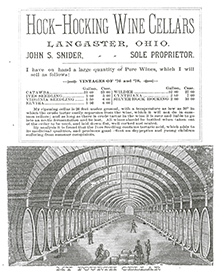
-
1871
Lt. Col. Clemens F. Steele (son-in-law to Thomas Ewing Sr.) bought the property and more than doubled the original square-footage in 1873, adding beautiful woodwork, including the stairs and trim details in the structure's south section, which remain largely intact today.
ENLARGE IMAGE
The Semi-Weekly Gazette described Steele as a "most interesting character" who was a veteran of the Mexican and Civil wars. He also sought a fortune in the California gold rush, which eventually led him to adventuring in South America.
Steele owned this home for six years before selling it for $12,000 John Gill, a wealthy Walnut Township farmer.
Gill subsequently sold this home to his son-in-law and daughter Charles and Adele Martin, who lived there for about 10 years before moving to a farm in Brice, Ohio. The Martins then rented the High Street home to the W. B. Maccracken family in 1893.
Pictured: A beautifully crafted wooden staircase added when Lt. Col. Clemens F. Steele owned this home.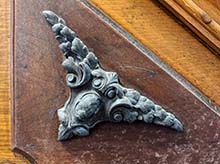
-
1895
After renting the property from Charles and Adele Martin for about two years, Elizabeth Maccracken (the wife of William B. Maccracken) purchased the property for $7,500 on Feb. 5, 1895.
ENLARGE IMAGE
The Maccrackens had previously lived from 1886 to 1892 in a house built in 1832 for William’s grandfather. It is today the Georgian Museum, 105 E. Wheeling St.
Pictured: Maccracken family portrait.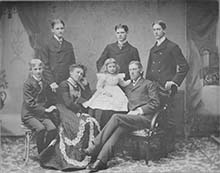
-
1901
Edith M. Hankes, niece of W.B. Maccracken, married William H. Vanderpoel at St. John’s Episcopal Church on June 18, 1901. The wedding reception was held at the Maccracken home at 108 N. High St.
ENLARGE IMAGE
"The spacious verandas were enclosed with white canvas and hung with Japanese lanterns. The halls, staircase and reception rooms were beautifully decorated with ferns, smilax and potted plants ...,"according to an account that appeared in the Gazette the following day.
Pictured: (left to right) One of the reception rooms celebrating the Vanderpoel and Hankes wedding; Portrait of Edith M. Hankes on her wedding day.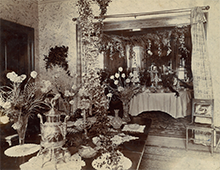
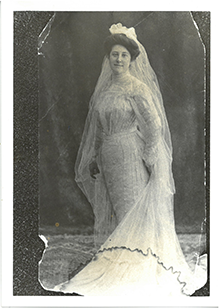
-
1900
Elizabeth Maccracken organized the first local gathering of the Elizabeth Sherman Reese Chapter of the Daughters of the American Revolution in this home on April 23, 1900.
ENLARGE IMAGE
This home might have also been the location of Lancaster's first kindergarten classroom around 1900, according to the oral history of Mary Maccracken Donkle (Elizabeth Maccracken’s daughter), who was a young girl at the time. She recalled the kindergarten teacher lived and taught in a back room on the home’s High Street side. Donkle said the teacher would leave with a pony and cart to pick up children who did not live nearby.
Pictured: (left to right) Portrait of Elizabeth Maccracken and daughter Mary in 1894; Portrait of Elizabeth Maccracken, age 48.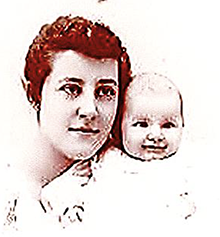
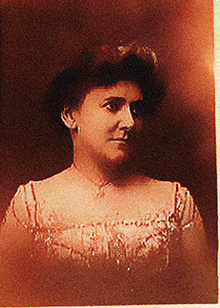
-
1901
The Maccrackens sold this home to Dr. George O. and Gabrielle Beery and her mother Mary Smith for $7,500 on July 1, 1901. They moved in two days later.
ENLARGE IMAGE
Dr. Beery, a practicing physician in Lancaster for 50 years, operated his office inside this home in addition to serving as a physician at the private Park Street Hospital. The private hospital operated from 1907 to 1915 and often served the more wealthy citizens.
Beery was a leader in the movement to build Lancaster’s first municipal hospital. He helped generate funds and awareness for what would become the $60,000, three-story Lancaster Municipal Hospital in 1916. Upon opening, the hospital on North Ewing Street had eight nurses, 36 beds and 10 bassinets.
Pictured: (left to right) Portrait of Dr. George O. Beery; Dr. George and Gabrielle Beery standing for a photograph at 108 N. High St.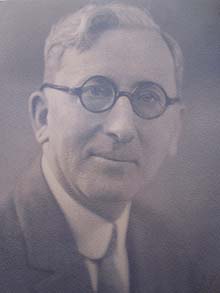
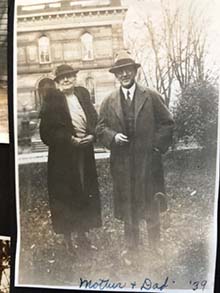
-
1926
The Beery's daughter, Marian, married John F. Furniss in this home on Nov. 16, 1926, with 150 guests in attendance for the ceremony and luncheon reception.
ENLARGE IMAGE
The Daily Eagle published full details of the wedding, including its decorations: "Ferns and palms were massed in the window while laurel sprays covered the archway." Throughout the house were orchids, laurel and yellow Buckingham pompoms and satin streamers on the mantles and stairway.
Marian Beery Fruniss was one of the founding members of the Fairfield County Heritage Association.
Pictured: Marian Furniss Beery in her wedding dress.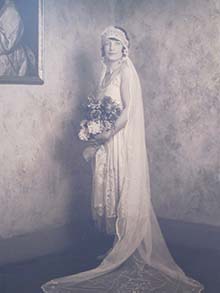
-
1941
Dr. Beery died at 71 on Jan. 25, 1941, after a heart ailment and failing health for about a year. Gabrielle Beery sold this home to Phil R. Peters and Russell Rising on May 6, 1941.
ENLARGE IMAGE
By 1942, this home had been turned into a public building for the first time. The local Red Cross headquarters moved in and operated there for about a decade. During World War II the Red Cross helped the relief effort by sewing and knitting countless garments for soldiers and refugees, training nurses and raising thousands of dollars for the War Fund.
Coincidentally one of the original signers of the petition to organize the local Red Cross chapter was Elizabeth Mccracken, who resided in this home from 1893 to 1901.
Pictured: Red Cross volunteers fold surgical dressings at the 108 N. High St. headquarters in 1942. Photograph appeared in Lancaster Eagle-Gazette article "Red Cross Chapter here one of foremost in Ohio" on June 9, 1950.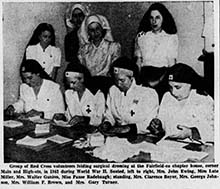
-
1951
The Peters and Risings sold the property in 1951 to Roi DeLancy, who rented the building as office and apartment space. One tenant was prominent physician Dr. John W. Edwards.
ENLARGE IMAGE
Edwards was a general practitioner in Lancaster for 15 years, opening his office on the first floor of the Beery House in 1954. Edwards’ daughter Lise Ricketts remembers her father worked long hours, seeing patients at his office, making house calls, delivering babies and being on call at the emergency room. Edwards was also president of the Fairfield County Cancer Society.
Pictured: (left to right) Photograph of Dr. John W. Edwards; Newspaper clipping regarding the opening of Dr. Edwards’ first practice at 108 N. High Street dated Nov. 8, 1954.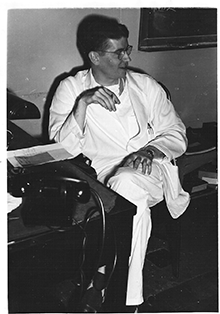
-
1960
The 1960s marked the first of several decades that this building would be used for county and city business.
ENLARGE IMAGE
DeLancy sold the property in 1960 for $40,000 to the Fairfield County Commissioners, who had reported a need due to insufficient space in the courthouse. In 1961 the Fairfield County Welfare Department was the first county office to occupy the space.
Pictured: Newspaper clipping describing the Fairfield County Welfare Department’s role and increasing caseload in Lancaster Eagle-Gazette on July 12, 1962.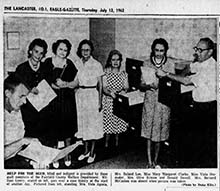
-
1963
The city and county health department moved their offices into eight rooms on the newly remodeled first floor. The department stayed for 23 years before moving operations to the Clarence E. Miller Health & Human Services Building Complex in 1986.
ENLARGE IMAGE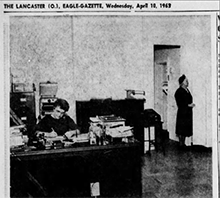
-
1969-1979
The Fairfield County Board of Education also occupied the second floor from 1969 to 1976.
-
1986
After the health department and board of education left the building, the Fairfield County Commissioners quickly found a new use for the space. In November 1986, the civil and fiscal services of the Fairfield County Sheriff moved to the first floor, and the detective bureau operated from the second floor.
ENLARGE IMAGE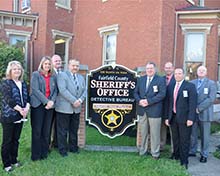
-
2017
The sheriff's office vacated this historic building in June 2017 to move into a newly constructed $34.7 million Fairfield County Jail and Public Safety Facility on Lincoln Avenue.
-
2019
The Fairfield County Auditor's Office began renovations of the 5,800 square-foot building after the county signed a $2.3 million construction contract that included a 2,300 square-foot expansion to the back of the structure.
ENLARGE IMAGE
The building was upgraded to meet the physical accessibility standards of the Americans with Disabilities Act, including the addition of elevators and commercial restrooms. This has been the most significant upgrade for the building since the last major renovation in 1873.
Pictured: The interior at 108 N. High Street while the auditor’s office renovations by Gutknecht Construction were underway.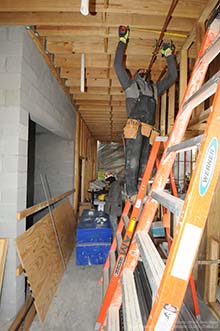
-
2020
The Fairfield County Auditor's Office opened in April 2020 bringing new life to the now 8,100 square foot building under the direction of Auditor Jon Slater. The building houses 14 employees, the real estate assessment office, work stations for geographical information system mapping and a public meeting space for tax-related appeal issues.
ENLARGE IMAGE
Pictured: 2020 exterior view of 108 N. High St.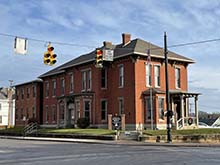
Timeline compiled by Remo Remo Design
Timeline design by Web Chick
